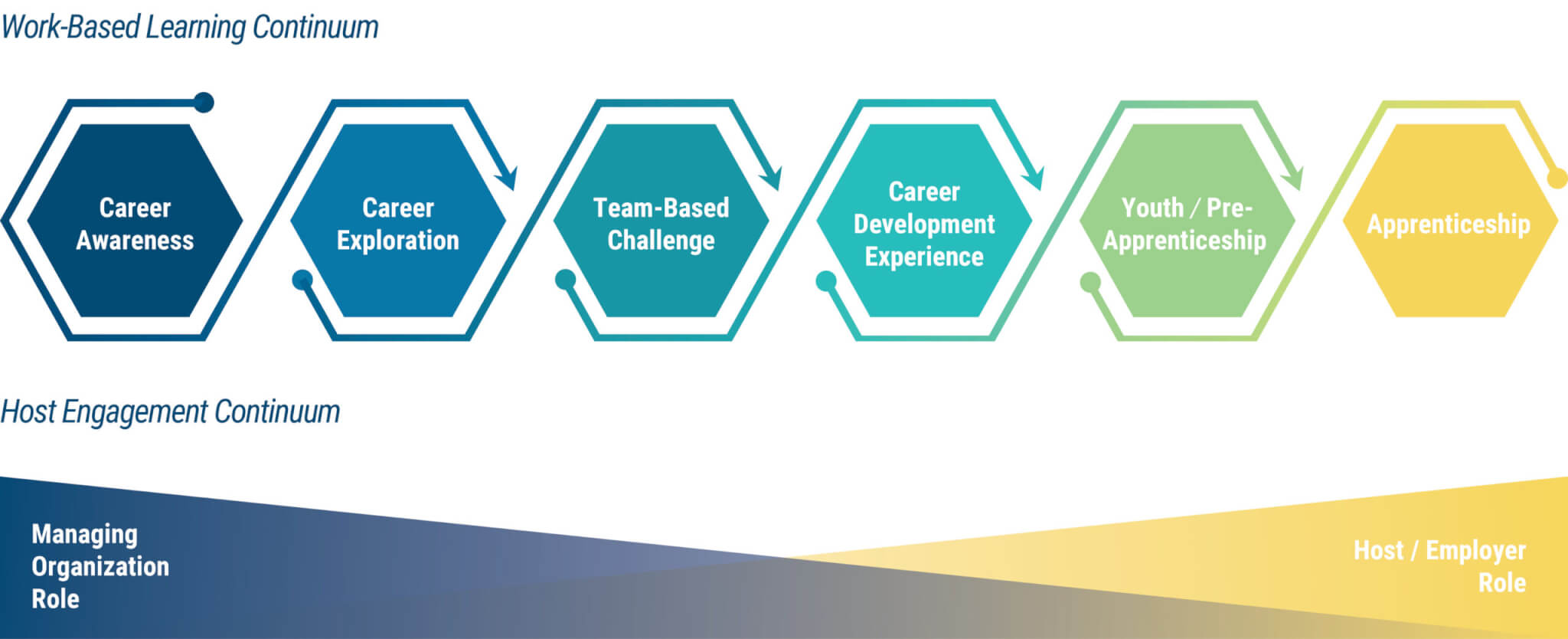Work-based learning practitioners often grapple with how best to navigate employer partnerships. Questions we often hear include:
- How do we grow new and existing partnerships in a way that is valuable and not overwhelming to partners?
- What factors influence partner decisions to pay or not pay interns, and how do they impact student participation and equity?
- What strategies work best to align students’ passions with industry needs?
At our recent I-WIN roundtable discussion, stakeholders gathered to address these questions and shared a blend of innovative ideas, practical solutions, and lingering challenges. Whether you’re an educator, employer, or community partner, we hope that their insights, gathered below, will inspire action as we collectively work to engage with partners and empower students through meaningful work-based learning experiences.
Growing Partnerships
Expanding employer partnerships brings both opportunities and challenges. Communities can become saturated as work-based learning programs grow, and schools look to find new partners rather than repeatedly approaching (and potentially exhausting) the same employers. To better communicate their program to current and prospective partners, Naperville Community Unit School District created one-pagers highlighting the skill sets students bring to the table and providing detailed information about the courses they have completed. Rockford Public Schools (RPS) collaborates with partners to explore various ways they can engage and identify their preferred levels of involvement. This information is tracked in a database to organize outreach efforts and strategically encourage partners to progress along the work-based learning continuum. When partners volunteer to support a new experience along the continuum, RPS provides detailed guidance and explicit expectations for how participating in an internship, for example, differs from a job shadow.
A common theme from the communities is that smaller companies often yield early successes, as the decision-makers are closely involved with students. In comparison, larger companies may support fewer types of experiences but accommodate more students overall. Also, to grow new and existing partnerships, it’s important to remember that the partner representative who is saying yes to the experience is not necessarily the adult who will be working directly with students. It’s crucial to have a clear understanding of who will mentor the student and create a plan for how the employer will support the experience before the student’s first day.
Ideally, many communities wish to incorporate new employer partners in experiences earlier in the work-based learning continuum, such as job fairs or guest speaking, as these have easier entry points and are less of a time and resource commitment. As the relationships with the employer partners deepen, they hope to recruit them into opportunities further along the continuum, such as serving as an industry mentor for a team-based challenge or hosting an intern. However, stakeholders shared that some industries can be trickier than others to move along the continuum. Employer-facing resources, like EdSystem’s one-pagers for hosting high school internships in manufacturing, and myth-busting events, such as Valley Industrial Association’s training on labor laws, can help address common employer concerns.

Building New Partnerships
Building new partnerships for work-based learning requires proactive and diverse strategies since partners have different ways of wanting to be engaged. Multiple communities shared that their recruitment efforts often begin at Chamber of Commerce and Rotary events, using membership directories to identify businesses that are already proactively engaged in the community. Evanston Township High School shared some of their more creative approaches, which include attending career fairs, visiting hotels to recruit for their hospitality pathway, and leveraging alumni networks through newsletters, football games, or online forms for follow-up. Some districts, including District 214, use placement specialists to match students with employers, employing tactics like cold calls, scripted outreach, and tracking interest in spreadsheets. Regular communication, such as quarterly newsletters, also helps recruit partners. By combining these methods, schools can establish meaningful connections to support student success.
Exploring In-House Opportunities
Exploring in-house work-based learning opportunities can address barriers such as transportation and I-9 documentation while leveraging school district resources and staff expertise. A variety of schools are already implementing school-based enterprises, a simulated or actual business conducted within a school. Additionally, more schools are looking to host internships within their district that reflect what occurs at an external employer partner. For instance, at Naperville Community Unit School District and Rockford Public Schools, information technology pathway students gain hands-on experience through roles such as help desk support, software engineering, and working with district IT teams. Other examples include marketing pathway students assisting with district communication teams, accounting pathway students supporting school cashiers, and nursing pathway students learning alongside school nurses. Education pathways also thrive in-house, with students job shadowing across pre-K to high school settings, providing exposure to various grade levels. District 100 shared that when confidentiality concerns have posed challenges, solutions like transitioning education internships to feeder schools have proven effective in maintaining privacy while supporting student learning. Learn more about community models of school-based enterprises.
Paid vs. Unpaid Internships
Communities noted that some long-standing employer partners are transitioning from offering unpaid opportunities to paying students. This shift reflects their recognition of the value of work-based learning and their desire to address liability and insurance concerns by formally onboarding high school students as employees. While this is a positive development, it raises questions about the impact on partners who do not offer paid opportunities and how decisions are made regarding which students participate in paid versus unpaid experiences.
The debate between paid and unpaid internships often depends on the industry, the nature of the work, and employer preferences, with schools leveraging creative strategies to address both options. Districts such as RPS have used grant funds from the Scaling Transformative Advanced Manufacturing Pathways initiative to initially pay interns, opening doors with manufacturing partners who now independently host paid interns.
What communities have noticed is employers often pay students when the role involves significant work value, such as students coding for large audiences, or industries where liability issues arise, such as veterinary clinics and aviation. Conversely, mentorship-based experiences or roles in law firms tend to remain unpaid. Naperville Community Unit School District’s internship job board highlights paid opportunities to attract top-tier students, a feature that they share with employers to encourage compensation.
Innovative approaches, such as local nonprofit collaborations to serve as the employer of record, enable districts to invoice and pay students directly. Communities are also getting creative with their marketing to employers to encourage paid opportunities with messages such as “For less than $1,000, you can get a marketing campaign and/or IT support.”
Matching Student Interest with Partner Opportunities
As schools expand their work-based learning offerings, they are seeing increased student interest but are also facing challenges when student requests don’t align with what employers are willing to provide. To navigate this, RPS prioritizes students in relevant pathways for internships in their career areas. Maine Township High School District strives to accommodate student-driven placements, such as in physical therapy or meteorology, even when these interests fall outside established pathways. Naperville Community Unit School District has developed a streamlined process where employers submit internship descriptions via a form, and students select roles to apply for, submitting their resumes and cover letters directly. While this personalized approach yields strong partnerships and better outcomes, Naperville shared that it presents scalability challenges as enrollment grows. For students who don’t secure initial offers, one-on-one support helps identify alternative opportunities, ensuring all students can engage while continuing to expand employer networks to meet demand.
The Conversation Continues
Work-based learning offers a valuable opportunity to bridge education and industry, but it also requires thoughtful collaboration and innovation to overcome challenges. By sharing these insights, we hope to inspire educators, employers, and community partners to explore new strategies, deepen connections, and address lingering questions.
Join us for our next roundtable discussion on work-based learning systems and processes on Tuesday, December 17, 2024, at 12 p.m. To join the discussion, please register now.


